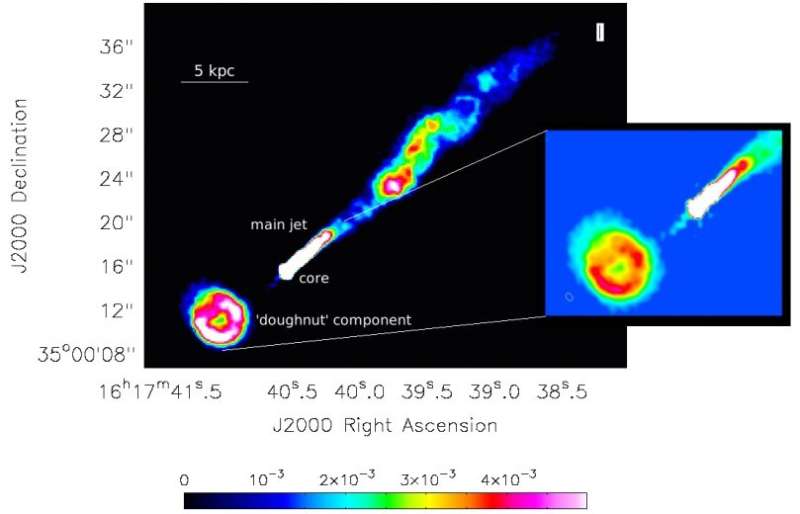August 15, 2018 report
Unusual doughnut-shaped jet observed in the galaxy NGC 6109

Astronomers from the University of Bristol, U.K., have uncovered an unusual doughnut-shaped jet in the radio galaxy NGC 6109. It is the first time that such a jet morphology has been observed in a low-power radio galaxy. The finding is detailed in a paper published August 6 on the arXiv pre-print repository.
Located approximately 400 million light years away, NGC 6109 is a low-power, head-tail radio galaxy. Observations of this galaxy four decades ago with the Westerbork Synthesis Radio Telescope (WSRT) revealed its radio tail extending for a projected distance of about 800,000 light years. Subsequent studies of this galaxy also revealed the presence of a counter jet located opposite its main jet.
Now, new observations of NGC 6109 conducted by a group of researchers led by Josie Rawes provide insights into the morphology of the counter jet. The observational campaign was carried out with the use of the Karl G. Jansky Very Large Array (VLA) in New Mexico in order to investigate how low-redshift radio galaxies interact with the external environment. One of the findings of this campaign is the detection of a doughnut-shaped morphology of the counter jest in NGC 6109.
"VLA radio observations of this source reveal a remarkable 'doughnut' component emitted on the opposite side of the core to a relatively straight jet," the astronomers wrote in the paper.
According to the study, radio polarimetry observations of the doughnut-shaped jet show a complex magnetic field structure across this component, directed predominantly radial to the jet axis. Moreover, high rotation-measure structures are found for this component. The researchers added that no infrared, optical or X-ray emission is associated with this unusual feature.
Furthermore, the observations provided evidence for an interaction between the jet and the external environment. This could be the cause of the jet's unusual morphology.
In concluding remarks, the researchers suggest a possible hypothesis explaining what kind of interaction could be behind the jet's doughnut shape. They noted that this morphology might be explained, for example, by a ballistic precession model.
"This could be due to an external wind pushing against the component, which causes it to become diffuse and sweep back along the direction of the main jet, but the absence of X-ray or optical emission suggests that the density of the external gas is very low," the paper reads.
The researchers also assume that an interaction model where the path of the counter jet is disrupted due to the external environment is possible, as well.
"A simple hydrodynamical model would require a very light jet to produce the tight doughnut structure. The presence of strong rotation-measure structure to the south of the doughnut suggests an enhanced density or field in that region," the authors concluded.
However, the scientists added that further investigation of NGC 6109 is required in order to determine which of the hypotheses is most plausible. They emphasized that optical observations and hydrogen-alpha imaging, as well as lower frequency, high-resolution observations of the galaxy should be conducted to better understand the mechanism behind the morphology of the unusual jet.
More information: Extreme jet bending on kiloparsec scales : the 'doughnut' in NGC 6109, arXiv:1808.01967 [astro-ph.GA] arxiv.org/abs/1808.01967
Abstract
We present new radio observations of the z = 0.029 radio galaxy NGC 6109, a member of the 3CRR sample. We find the radio morphology of the counter-jet to be highly distorted, showing a unique 'doughnut' structure ~6 kpc in diameter. The doughnut is overpressured compared with the surrounding atmosphere as measured with Chandra. We investigate the polarisation properties of the source and find evidence for an interaction between the doughnut and the external environment. This may cause the extreme jet bend. Alternatively, while providing no explanation for the rotation-measure and magnetic field structure seen in the doughnut, a ballistic precession model may be feasible if the ballistic flow persists for a distance much less than the full extent of the 100 kpc-scale jet. A light jet being deflected by gas flows and winds just outside the transition between the galaxy and cluster atmospheres appears to be a more plausible interpretation.
© 2018 Phys.org




















